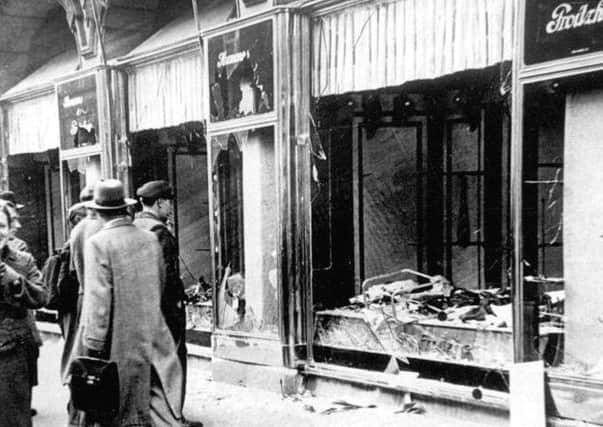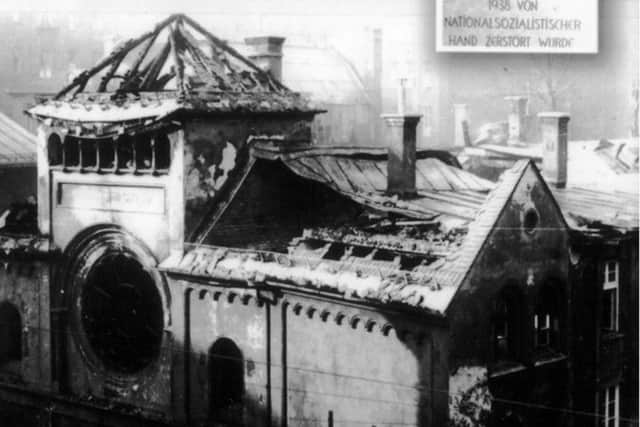Kristallnacht's orgy of violence against Germany's Jews presaged the Holocaust


Ernst vom Rath was a career diplomat serving in the German embassy in Paris. On November 7 1938 he was assassinated by Herschel Grynszpan, a Polish teenager. This event provided the pretext for the Kristallnacht (Night of Broken Glass).
Even before this, Jews had been increasingly forced out of the German economy, deprived of their livelihoods and driven to the fringes of a proclaimed ‘people’s community’ defined on the basis of racial discrimination and persecution.
Advertisement
Hide AdAdvertisement
Hide AdSendel and Riva Grynszpan were ‘Polish’ Jews who had emigrated to Germany in 1911 and settled in Hanover. On October 27 1938 they, along with 17,000 other Jews were deported to Poland. They were ordered to leave their homes in a single night, and were allowed only one suitcase per person to carry their belongings. As the Jews were taken away, their remaining possessions were looted by the Nazi authorities and their neighbours. At the trial of Adolf Eichmann in 1961 Sendel Grynszpan told the Jerusalem District Court: ‘They [the Nazis] took us in police trucks, in prisoners’ lorries, about 20 men in each truck, and they took us to the railway station. The streets were full of people shouting: “Jews out, out to Palestine!”’


The expelled Jews were dumped by the Nazis at the Polish border. Because the Poles refused to allow them to enter, most of the deportees were stranded in the no-man’s-land between Germany and Poland near the town of Zbaszyn.
This stalemate continued for days in the pouring rain, with the Jews marching without food or shelter between the borders. Four thousand were granted entry into Poland, but the remainder were forced to stay at the border.
Herschel Grynszpan, the Grynszpans’ 17-year-old son, was living with an uncle in Paris.
Advertisement
Hide AdAdvertisement
Hide AdHerschel received a postcard from his family from the Polish border, describing the family’s expulsion: ‘No one told us what was up, but we realised this was going to be the end ... We haven’t a penny. Could you send us something?’
Distressed and unhinged by the news of his parents’ treatment, on November 7 1938, Herschel purchased a revolver and a box of bullets. He then went to the German embassy and asked to see an embassy official. Having been shown into vom Rath’s office, he fired five bullets at Vom Rath, two of which hit him in the abdomen.
Although vom Rath was a Nazi Party member, he had expressed anti-Nazi sympathies and was under Gestapo investigation for being politically unreliable.
Despite this, Hitler sent Karl Brandt, his personal physician, and Georg Magnus, a surgeon, to Paris to try to save vom Rath’s life but he was beyond help. In the hours before vom Rath’s death on November 9, Hitler promoted vom Rath, who had been only a junior officer at the embassy, to the rank of Legal Consul.
Advertisement
Hide AdAdvertisement
Hide AdThe Nazis, notably Joseph Goebbels, used the shooting to inflame further anti-Semitism, claiming that Grynszpan did not act alone, but was part of a wider Jewish conspiracy against Germany.
Within hours of vom Rath’s death, the Nazis unleashed a horrendous orgy of violence – the Kristallnacht – against the Jewish community across Germany.
The name Kristallnacht is a reference to the shards of broken glass from Jewish homes and businesses.
The ferocity of Kristallnacht far surpassed previous episodes in 1933 and 1935. It would be naive to suppose that the events of Kristallnacht were spontaneous. The Nazis had planned an outbreak of violence against the Jews and were simply waiting for the appropriate provocation.
Advertisement
Hide AdAdvertisement
Hide AdNearly a hundred Jews were murdered (91 according to official German statistics but almost certainly a serious underestimate).
When deaths from post-arrest maltreatment and subsequent suicides are included, the death toll climbs into the hundreds. Countless others were beaten up. Some 30,000 Jewish men were arrested and incarcerated in concentration camps.
There was widespread destruction of synagogues and Jewish property.
Homes, hospitals and schools were ransacked and buildings demolished by men wielding sledgehammers. Of 9,000 Jewish businesses in Germany, 7,500 were either destroyed or damaged.
Advertisement
Hide AdAdvertisement
Hide AdOver 1,000 synagogues were burned. Tombstones were uprooted and graves violated. Fires were lit, and prayer books, scrolls, artwork and philosophy texts were thrown upon them.
The police and fire brigades deliberately stood aside.
The Nazis imposed a fine of one billion Reichsmarks – the Judenvermögensabgabe – on the Jewish community and ordered them to clean up after the pogrom. They were prevented from collecting insurance for the damage. The Germans confiscated payments owed by insurers to Jewish property holders.
Furthermore Jewish children were excluded from German state elementary schools, Jewish cultural activities were indefinitely suspended, and publication of Jewish newspapers and magazines (including the three national German Jewish newspapers) were halted.
Kristallnacht represented a turning point for German Jews. Previously persecution of the Jews was essentially economic, political and social. Henceforth it became physical, as Jews were beaten, incarcerated and murdered. Some contend that Kristallnacht was the first day of the Holocaust.
Advertisement
Hide AdAdvertisement
Hide AdThe London Times observed: ‘No foreign propagandist bent upon blackening Germany before the world could outdo the tale of burnings and beatings, of blackguardly assaults on defenceless and innocent people, which disgraced that country yesterday.’
The Daily Telegraph correspondent in Berlin reported: ‘Mob law ruled in Berlin throughout the afternoon and evening and hordes of hooligans indulged in an orgy of destruction. I have seen several anti-Jewish outbreaks in Germany during the last five years, but never anything as nauseating as this. Racial hatred and hysteria seemed to have taken complete hold of otherwise decent people. I saw fashionably dressed women clapping their hands and screaming with glee, while respectable middle-class mothers held up their babies to see the “fun”’.
However, the evidence of the diplomatic community in Berlin is overwhelmingly that most Germans did not approve of the events of Kristallnacht. For example, the son of a US consular official heard the janitor of his block cry: ‘They must have emptied the insane asylums and penitentiaries to find people who’d do things like that!’